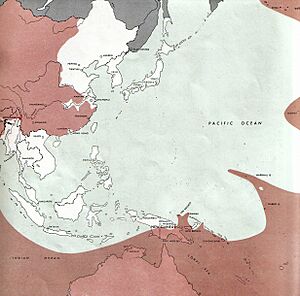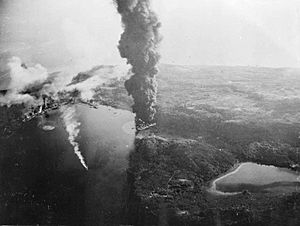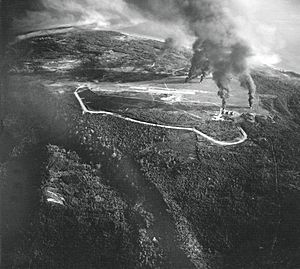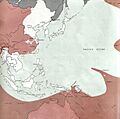Operation Cockpit facts for kids
Quick facts for kids Operation Cockpit |
|||||||
|---|---|---|---|---|---|---|---|
| Part of the South-East Asian theatre of World War II | |||||||
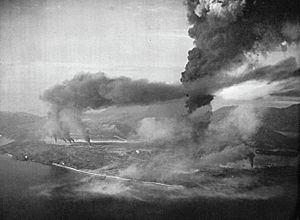 Sabang under attack on 19 April 1944 |
|||||||
|
|||||||
| Belligerents | |||||||
| Commanders and leaders | |||||||
| Strength | |||||||
| 2 aircraft carriers 3 battleships 1 battlecruiser 6 cruisers 15 destroyers 1 submarine |
Anti-aircraft batteries 3 torpedo bombers |
||||||
| Casualties and losses | |||||||
| 1 aircraft destroyed | 1 merchant vessel sunk 1 merchant vessel beached Up to 24 aircraft destroyed on the ground 3 aircraft shot down |
||||||
Operation Cockpit was a secret mission by the Allied forces during World War II. On April 19, 1944, planes from British and American aircraft carriers attacked the Japanese-held island of Sabang. This island is located near Sumatra in what was then the Dutch East Indies.
The main goal was to hit Japanese ships and airfields. The attack destroyed some Japanese ships and planes. The Allies lost only one American aircraft. Even though the attack was a success for the Allies, it didn't make the Japanese move their forces away from other important areas, which was one of the hopes.
This attack on Sabang was the first of many carrier raids by the British-led Eastern Fleet in 1944 and 1945. The Allies wanted to stop Japan from sending more forces to stop an American landing in New Guinea. The Japanese defenders at Sabang were surprised, and they didn't put up much of a fight. The Japanese didn't see the Eastern Fleet as a big threat. They were saving their forces for a major American attack in the Central Pacific. Still, the Allies were happy with the results of Operation Cockpit.
Contents
Why Did the Allies Attack Sabang?
From mid-1942 to early 1944, the Allies didn't do many naval attacks in the Indian Ocean. Their main naval group there, the British-led Eastern Fleet, wasn't very strong. It didn't have any aircraft carriers for a while, and its older battleships were moved away. This meant the fleet could only protect Allied ships. Luckily, the Japanese didn't try any big attacks in the Indian Ocean either. This allowed the Eastern Fleet to focus on fighting German and Japanese submarines.
At a big meeting called the Cairo Conference in November 1943, Allied leaders decided that the main fight against Japan would be in the Pacific. The Indian Ocean would be a smaller area of operations. They also agreed that any attacks in the Indian Ocean, including carrier raids, should "keep pressure on the enemy" and "force them to spread out their forces."
In January 1944, the British Admiralty, which ran the Royal Navy, decided to make the Eastern Fleet much stronger. This was possible because the Italian Navy had surrendered in 1943. This meant the Royal Navy had fewer enemies and the Allies controlled the Mediterranean Sea. Over the next four months, 146 new warships were sent, including three battleships, two aircraft carriers, fourteen cruisers, and many destroyers. The first big group of these ships arrived at the fleet's base in Ceylon on January 27. This group included the aircraft carrier HMS Illustrious, battleships HMS Queen Elizabeth and Valiant, and the battlecruiser HMS Renown.
Around the same time in early 1944, the Japanese military moved its main naval force, the Combined Fleet, to Singapore. They did this to move their ships away from bases in the central Pacific, which were now open to American attacks. Singapore had good ship repair places and easy access to fuel. The Japanese didn't plan any big attacks into the Indian Ocean. However, the Allies were worried about what the Combined Fleet might do. Admiral James Somerville, who led the Eastern Fleet, thought his force couldn't stop the Japanese if they entered the Indian Ocean. So, more Allied air units were sent to protect Ceylon. The United States Navy also agreed to temporarily send the aircraft carrier USS Saratoga and three destroyers from the Pacific to help the Eastern Fleet.
Sabang island is off the northern tip of Sumatra. The Imperial Japanese Navy (IJN) used it as a base during the Japanese occupation of the Dutch East Indies. Its location at the northern entrance of the Strait of Malacca made it very important. The IJN's 9th Base Force was the main unit at Sabang, led by Rear Admiral Hirose Sueto. The British thought there were 9,000 Japanese soldiers on the island.
Getting Ready for the Attack
In late March, the main part of the Eastern Fleet, including Illustrious, Renown, Queen Elizabeth, and Valiant, sailed into the Indian Ocean. This mission, called Operation Diplomat, had two main goals. First, to look for Japanese ships after a small Japanese cruiser attack. Second, to meet up with the American carrier Saratoga. The operation also helped the ships practice working together and refuelling at sea. This practice was important before the fleet started its own attacks. The British ships left Ceylon on March 21, refuelled from tankers from March 24 to 26, and met Saratoga on March 27. The aircraft from both carriers practiced together on the way back, and the fleet returned to Ceylon on April 2.
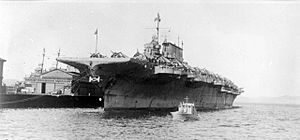
The decision to attack Sabang came from Admiral Ernest King, the head of the US Navy. King asked the Eastern Fleet to attack in mid-April. This was to stop Japanese naval aircraft in southern Malaya from attacking the large Allied naval forces that were going to land at Hollandia in New Guinea on April 22. On April 12, the Eastern Fleet's leaders decided to launch a carrier attack on Sabang. They also planned to have surface ships bombard Sabang, but they decided not to do this just before leaving. They thought it would be too risky to operate so close to the shore. This raid was seen as a test to prepare the fleet for bigger missions. For the first two weeks of April, the Eastern Fleet finished its plans and practiced the attack. This would be the Eastern Fleet's first aircraft carrier raid.
The Allies didn't have much information about the Japanese forces at Sabang. They only had a few aerial reconnaissance photos. They believed the island was strongly defended, with a radar station and an airfield. Admiral Somerville decided not to send more reconnaissance flights over the island. He didn't want to warn the Japanese. Information from breaking German and Japanese codes helped plan Operation Cockpit. It allowed the Allies to track where enemy warships and air units were. The Far East Combined Bureau also created a radio trick that worked well.
Despite the Allies' plans, the Japanese weren't very interested in fighting the Eastern Fleet. The IJN knew the fleet wasn't strong enough to be a big threat. They were saving their forces, including the planes in southern Malaya, to fight the American advance through the central Pacific. The Combined Fleet was told to only fight the Eastern Fleet if it launched a very large attack.
The Attack on Sabang
The attack force left the Eastern Fleet's main base at Trincomalee on April 16. Admiral Somerville personally led the mission from Queen Elizabeth. The force included 27 warships from six different navies. One historian noted that Operation Cockpit was "perhaps the most diverse naval operation of the war."
The Royal Navy sent Illustrious, two battleships, one battlecruiser, four cruisers, and seven destroyers. The American group had Saratoga and three destroyers. Other ships included the French battleship Richelieu, the Dutch cruiser HNLMS Tromp and a Dutch destroyer, the New Zealand cruiser HMNZS Gambia, and four Australian destroyers. The Allied ships were split into two groups. Task Force 69 was a battleship covering force with three battleships, two cruisers, and nine destroyers. Task Force 70 had the aircraft carriers, Renown, two cruisers, and six destroyers. The submarine HMS Tactician was also near Sabang to rescue any pilots who might be shot down. This was the largest force the Eastern Fleet had ever sent into battle.
Each aircraft carrier had its own group of planes. Illustrious had two squadrons with 14 Vought F4U Corsair fighters each. It also had two squadrons with a total of 21 Fairey Barracuda torpedo and dive bombers. Saratoga had a squadron with 26 Grumman F6F Hellcat fighters, a squadron with 24 Douglas SBD Dauntless dive bombers, and a squadron with 18 Grumman TBF Avenger torpedo bombers. Commander Joseph C. Clifton, who led Saratoga's air group, was in charge of the planes from both carriers during Operation Cockpit.
After a quiet journey, and without the Japanese knowing, the Allied force arrived at the launch point. This was about 100 miles (160 km) southwest of Sabang, early on April 19. The planes started taking off at 5:30 a.m. Illustrious sent 17 Barracudas and 13 Corsairs. Saratoga sent 24 Hellcats, 18 Dauntlesses, and 11 Avengers. Sixteen of the Hellcats were to protect the other planes, and eight were to attack Lho Nga airfield in northern Sumatra. Commander Clifton led the planes in the air. Four Corsairs and eight Hellcats stayed over the fleet to protect it.
The attack on Sabang started at 7 a.m. Saratoga's planes arrived over the island first, and Illustrious' planes started their attack from a different direction a minute later. The Allied bombers mainly hit oil storage tanks, ships, and port buildings. The fighters attacked Sabang's airfield and Lho Nga airfield. Three of Sabang's four oil tanks caught fire, and the port buildings were badly damaged. Not many ships were in the area, but one merchant ship was sunk, and another was pushed onto the shore. The fighter pilots said they destroyed 21 Japanese aircraft at Sabang airfield and three more at Lho Nga.
The Japanese at Sabang were completely surprised. Their anti-aircraft guns only started firing after the attack began. No Japanese fighter planes were seen in the air. One Hellcat was shot down, but its pilot was rescued by Tactician while under fire from coastal artillery. Commander Clifton led a group of fighter planes that chased away a Japanese torpedo boat that was threatening the submarine during the rescue. Eleven other American planes were damaged.
As the Allied fleet left, three Japanese Mitsubishi G4M torpedo bombers approached. All of them were shot down by Hellcats about 50 miles (80 km) northeast of the ships. Allied warships fired at Japanese aircraft twice during the night of April 19/20. Some destroyers also fired at what turned out to be an Allied Douglas DC-3 transport plane flying from Cocos Islands with its identification system turned off. During a rain squall on the afternoon of April 20, Renown mistook the Australian destroyer HMAS Nepal for a Japanese ship and briefly fired at it. The attack force returned to Ceylon on April 21.
What Happened After?
The Allies were happy with the results of Operation Cockpit. While it didn't cause huge losses for the Japanese, the Royal Navy learned important lessons. The British were especially impressed with how Saratoga's crew managed their flying operations more efficiently. Commander Clifton was given an honorary award, the Distinguished Service Order, for his part in the operation.
The attack didn't change Japan's military plans or where they placed their forces. The aircraft in southern Malaya stayed there, and no changes were made to their plans to fight the Allied landings at Hollandia.
Soon after the attack force reached Ceylon, Saratoga was ordered to return to the United States for repairs. Admiral King suggested that she and most of the other ships from Operation Cockpit attack Soerabaya on her way back. This raid, called Operation Transom, happened on May 17. The Eastern Fleet carried out several other carrier raids in 1944. This included a second attack on Sabang on July 25, known as Operation Crimson. This operation involved two British aircraft carriers and included battleships firing at the island.
Images for kids
-
USS Saratoga at Hobart in March 1944 during her voyage to the Indian Ocean


